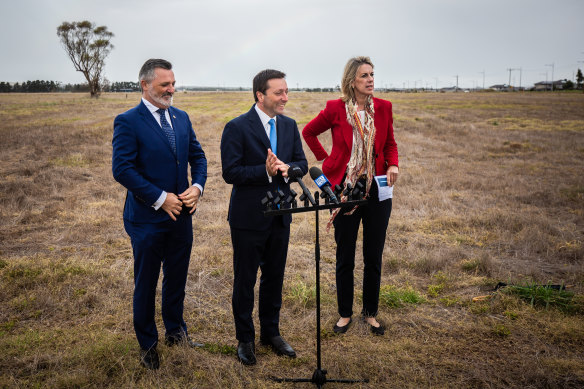The election bidding war over health policy in Victoria will intensify on Wednesday after the opposition releases a $325 million workforce plan to train 40,000 extra nurses and midwives via free education programs.
The Coalition’s Future Health Workforce Plan would see 18,000 more health workers trained than under a free education plan announced by Premier Daniel Andrews last month.
Opposition Leader Matthew Guy (centre) and health spokeswoman Georgie Crozier have unveiled billions in health promises in the lead up to the Victorian election. Credit:Scott McNaughton
“Nurses, midwives and other vital healthcare staff are the glue that holds our health system together,” said Opposition Leader Matthew Guy, who added that the plan was a real solution to fix the state’s health crisis.
In an important distinction between the two sides of politics, the Coalition plan would include 5000 nursing and midwifery degree scholarships totalling $16,500 offered to those who join the private health sector.
Labor’s announcement last month – which is now in place as government policy – includes a $16,500 scholarship, made up of $9000 to cover HECS and the remaining $7500 to cover the cost of study paid only to those who work in Victoria’s public health sector.
The opposition’s workforce plan follows an avalanche of promises they have made on new and upgraded hospitals across the state.
“Not only will we deliver at least 20 new and upgraded hospitals across Victoria but we will put the best trained and supported healthcare staff in them,” Guy said.
Victoria’s stressed health system has become the most hotly contested political battleground ahead of the November 26 election.
The state already needs 65,000 more health and community care workers in the next three years to meet demand and replace people retiring, according to a skills plan released by the government in August.
Along with workforce shortages even at existing hospitals, there are questions about how proposed new facilities would be staffed and built, with worker shortages across both the health and building industries, on top of supply chain problems, particularly in the regions.
Guy said the health promises would be delivered without new taxes or extra debt, paid for by shelving the first stage of Labor’s Suburban Rail Loop project. The state’s contribution to the $34.5 billion stage one is about $11 billion, with the rest coming from the federal government, private investment and value capture.
The Coalition plan includes 25,000 scholarships valued at $16,500 each for nursing and midwifery students – 20,000 for public health positions and 5000 for the private health sector – and 10,000 scholarships for existing nurses and midwives to upgrade their skills with fully paid postgraduate and specialist training. It also proposes to immediately recruit 5000 new nurses and midwives, both by funding re-training fees and establishing a new visa subclass for international health workers.
If the Coalition were elected, it would also establish a Victorian Ministerial Health Workforce Council that would, among other tasks, conduct a statewide public and private sector audit to inform the mix of newly funded roles.
The Australian College of Nursing welcomed the Coalition’s workforce policy, saying it represented good future planning.
“The health workforce is exhausted. They’re more than fatigued, they’re more than stressed and they’re more than burnt out,” said nursing college chief executive Kylie Ward.
“They’ve been working under duress for several years now, so I welcome any commitment that recognises the nursing workforce and the impact of working as tirelessly and under the pressure that they have.”
The Victorian Healthcare Association, which represents Victoria’s public health services, also welcomed the policy’s release, saying many of its promises aligned with what it had been calling for.
“It is great to see so many sensible policies on the table to help our public health services retain and attract more healthcare workers, and train future healthcare workers,” deputy chief executive Juan Paolo Legaspi said.
He said the healthcare worker shortage was the biggest problem affecting Victoria’s public system. “Every public health service in Victoria is trying to find workers to deliver critical services to their communities,” he said, with the state competing with other states and territories, the UK and New Zealand for workers.
Opposition health spokeswoman Georgie Crozier is a former nurse, midwife and diabetes educator who also worked in executive recruitment in health and biotech before entering parliament. She said the Coalition’s workforce plan would deliver a modern health workforce.
“We recognise the importance of nurses working in both the public and private system. This is a comprehensive plan that overhauls the way healthcare staff will be trained and supported by utilising existing experience and knowledge within the health system.”
The Victorian Healthcare Association told The Age this week that it was unclear how the parties have been deciding which projects to promise money to and why. It wants to see a more transparent process to compare the benefits of major hospital infrastructure bids, similar to Infrastructure Australia’s priority list, which lists unfunded nationally significant projects, many of them transport projects.
The Morning Edition newsletter is our guide to the day’s most important and interesting stories, analysis and insights. Sign up here.
Most Viewed in Politics
From our partners
Source: Read Full Article
